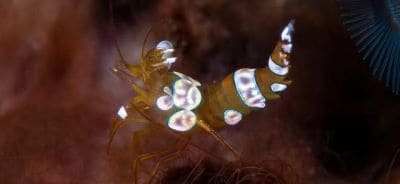Home › Sea Life › Animals › Invertebrate › Crustaceans › Shrimps › Squat Shrimp
Facts and Information about Squat Shrimps
[Phylum: Arthropoda] [Class: Malacostraca] [Order: Decapoda] [Family: Thoridae (Anemone Shrimp)]
The squat anemone shrimp (Thor amboinensis) is one of the most photogenic of all invertebrate crustaceans found living in shallow reef ecosystems.
This section explains more about the symbiotic relationship that it has with sea anemones (Actiniaria), and why its captivating behaviour has earned it the curious nickname of 'sexy shrimp'.
Some Interesting Facts about Squat Shrimp
The discovery of these small critters first occurred at Ambon Island in Maluku (Moluccas), Indonesia.
But, apart from the best dive sites in North Sulawesi, you will also find sexy shrimps living on corals in both hemispheres, including:
- Caribbean Sea
- Gulf of Mexico
- The Atlantic Ocean (e.g. Canary Islands, Madeira)
- The Red Sea
Hence, the pantropical distribution of this small-scale invertebrate means they exist in several large oceans (e.g. the Atlantic, Indian, and Pacific).
Pro Tip: Another section contains more information about the best place to scuba dive in Europe, Asia, and other incredible diving destinations around the world.
Unique Characteristics of the Sexy Shrimp
In a similar fashion to the broken-back shrimp (Hippolytidae), the sexy anemone shrimp also gets its name from one of its quirky behavioural traits.
The upward curve of a flexed abdomen, and the side to side rotation in a circular pattern, is only the beginning of the performance.
Imagine a colony of shrimp, each holding their fan-like tail above the head, while dancing on the ocean floor. This provocative behaviour of bobbing up and down may look like a sexy dance. In fact, this squatting posture appears to be part of their courtship ritual.
But wait - there's more:
The distinctive colouration of vivid orange and small white patches is intense. But, it differentiates squat anemone shrimps from most of the other common shrimp species.
Excluding tiny brine shrimp (Artemia salina), sexy shrimps growing no bigger than thirteen (13) millimetres long are worthy contenders for being the smallest.
Pro Tip: Another section contains a list of funny fish names used by scientists and the thought process behind a few of the weirdest names for marine animals.
Benefits of a Commensal Relationship
The association between Thor amboinensis and several other shallow water invertebrates is somewhat unique. It is a shared alliance that benefits the sexy shrimp to a much greater degree than the host.
 Nonetheless, the host species of the dancer shrimp and sea anemone relationship most often will be:
Nonetheless, the host species of the dancer shrimp and sea anemone relationship most often will be:
- Adhesive anemone (Cryptodendrum adhaesivum)
- Carpet anemone (Stichodactyla haddoni)
- Stinging anemone (Lebrunia danae)
- Fungiidae (especially mushroom corals in areas that lack suitable species of sea anemones)
This long-term biological interaction (called commensalism) occurs most in areas where there is little disturbance from strong wave action.
Even so, these social creatures spend most of their day in small groups congregating among the host's tentacles.
What Do Squat Shrimps Eat?
The parasites that would otherwise harm its host anemone will be part of a shrimp's regular diet. Hence, it gets a sheltered habitat among the "pseudo tentacles" as well as a plentiful food source (e.g. mucus-trapped planktonic particles).
However, being typical scavengers (and somewhat cannibalistic animals) means they will also eat algae, decaying worms, crabs, dead fish, sea snails, and even other dead shrimp.
How Do Squat Shrimps Reproduce?
After the mating process has taken place, the main role of the female is to carry fertilised eggs under her abdomen until they hatch.
The free-swimming crustacean zoea larvae will undergo several different life stages and metamorphosis. Chemical and visual cues in the water attract them to find, and settle near, their future host anemones.
Fun Fact: It seems there is a strong attraction for larvae of Thor amboinensis to choose the same host species of anemone as previously used by their parents.
Threats and Predators
According to the IUCN Red List of Endangered Species, the status of Thor amboinensis is Not Evaluated (NE). Even so, the typical predators of squat anemone shrimps in the ocean include the majority of small and medium-sized vertebrate fishes.
Keeping Shrimps in an Aquarium
Some aquarists like to keep squat shrimps in a nano aquarium or in a well-managed pico tank. In other words, it's best not to put pet shrimps and large marine fish in the same container.
You'll need to feed the shrimps on a regular basis. Otherwise, they will eat any sensitive corals (e.g. the ones they are hosted in) and other aquatic invertebrates.
Pro Tip: Another section contains information about keeping fish as pets in a reef aquarium. In general, aquarists who keep squat shrimps in captivity use small-size tanks for better viewing.
Related Information and Help Guides
- Cleaner Shrimp Fun Facts and Information
- Facts and Information about Sea Crabs
- Camel Shrimp Information with Pictures
- Mantis Shrimp Habitat and Range
- Sea Shrimp Facts and Species Information
Note: The short video [1:21 minutes] presented by 'Caribbean Reef Life' contains footage of a male sexy anemone shrimp fending off other males so he can mate.